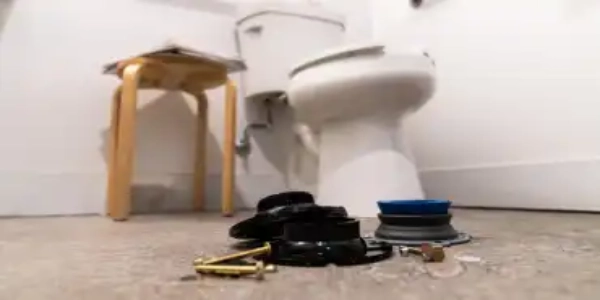
Summary:
- A toilet flange is a circular device that connects the toilet to the floor and wastewater lines, helping prevent leaks and sewer smells with a wax ring.
- To remove a toilet flange, you’ll need to gather tools, turn off the water, disconnect the toilet, and remove the flange by unscrewing or cutting it if necessary.
- Common signs of a damaged flange include sewer gas smells, a rocking toilet, and water pooling at the base of the toilet.
- Repairing a toilet flange may be possible for minor damage, while severe damage or corrosion typically requires a full replacement.
- To choose the right flange, measure the drainpipe, ensure a snug fit, and select a compatible material (e.g., PVC or ABS). Professional help may be needed for complex flange replacements.
We are all aware of how important toilets are for our daily lives. But people tend to take them for granted until they fail. Once that happens, you’ll quickly be reminded just how vital a toilet is to a well-functioning home, especially in a single-bathroom dwelling.
An aging toilet flange is one of the most common issues that can lead to a broken toilet. In this guide, we’ll explain how to remove and replace a toilet flange.
What is a Toilet Flange?
Before you even consider toilet flange repair or replacement, you should be well-informed about what a toilet flange is and how it works. A toilet flange is a circular device that nestles into the hole in the floor beneath a toilet. They are typically topped with a wax ring that blocks sewer smells and prevents water leaks.
Toilet flanges serve two critical roles:
- They link your toilet bowl with wastewater lines
- They anchor the entire fixture to the floor.
8 Steps to Remove a Toilet Flange
If you need to replace your toilet flange, you’ll need to know how to remove the old one. Most homeowners can pull off a successful removal, though it’s a bit more complicated than your average DIY project. Here’s how to remove a toilet flange:
- Gather your supplies. Make sure you have gloves, screwdrivers, adjustable wrenches, pliers, towers, and a shop vac. It’s also good to have a helper on hand.
- Turn off the water supply by rotating the water supply knob behind the toilet in a clockwise direction.
- Empty the toilet by flushing it repeatedly until the bowl and tank are empty. You’ll need to sponge out any water left in the bottom of the bowl and tank.
- Disconnect the toilet from the floor by removing the nuts from either side of the toilet with an adjustable wrench.
- With the help of a friend, gently rock the toilet back and forth to break the wax seal; then, carefully lift the toilet straight up. Move it out of the way. Be careful, as moving the toilet is often the most challenging part of the process due to its weight and odd shape.
- Use a putty knife to remove the wax seal of the flange from the floor and the underside of the toilet. Replace this with a new seal; choose another wax seal or opt for a new waxless option.
- Remove the toilet flange by unscrewing it from the floor. If the screws are in good condition, save them. You may need to pry out pieces of the old flange with a chisel and hammer. If the flange is stubborn, you can cut it into pieces with a Dremel tool. Once you have successfully removed the flange, use a shop vac and an old rag to clean debris from the area.
- Put the old flange in a plastic bag and take it to the hardware store to help you choose the correct replacement flange size.
3 Common Signs It’s Time to Replace Your Toilet Flange
To determine if your toilet flange needs replacement, look out for three signs:
- The smell of sewer gases: A distinct sewage smell near your toilet could indicate a broken flange or wax ring.
- A rocking toilet: Your toilet shouldn’t wobble like a table at a diner. If the toilet rocks, the flange is likely broken, and you should stop using it immediately, as the rocking could crack the toilet itself.
- Water pooling at the toilet base: If you notice water around the toilet’s base, it could be due to a leaking flange or a broken wax ring.
Toilet Flange FAQs
Not knowing everything there is to know about a toilet flange repair or replacement now doesn’t mean you never will! You can contact the expert team at Mr. Rooter Plumbing® to ask any flange-related questions. We’ve also answered some of our more commonly asked ones below:
Should you repair or replace a toilet flange?
Learning whether to replace or repair a toilet flange may end up saving you time and money. Use the following information to help you choose between repair and replacement options:
Signs of a damaged flange
If you notice signs of a damaged flange, you’ll need to explore repair or replacement sooner rather than later. Look out for uneven seating, wobbling, and leaking.
When to repair a flange
You might be able to undertake a toilet flange repair if the flange is only slightly loose or damaged. This process would involve removing the toilet, inspecting and assessing the flange, repairing any cracks or breaks, and reinstalling the toilet.
When to replace a toilet flange
If the flange is severely damaged, corroded, or made from incompatible materials, it’s best to replace it. This ensures a long-lasting and reliable solution.
When to hire a professional
Homeowners can usually complete simple repairs like tightening loose screws or replacing damaged wax rings. However, flange replacement is often a more intricate task that requires plumbing expertise.
How Do You Choose the Correct Size Flange?
Choosing the correct size toilet flange can be as straightforward as taking your damaged flange to your local hardware store and matching it. However, if this isn’t possible, there are other actions you can take:
- Measure the drainpipe
- Choose a flange that will fit snugly inside the drainpipe or slide over the pipe – most are three or four inches
- Choose a compatible material – e.g., a suitable flange for PVC or ABS
Should a Toilet Flange Go Inside Or Outside a Pipe?
Whether a toilet flange goes inside or outside a pipe depends on the flange you buy and your unique measurements. Many flanges for PVC and ABS applications fit over three-inch pipes or sit inside four-inch pipes. Some models are also designed to be installed on the outside of either three- or four-inch pipes. Contact a trusted plumbing professional if you’re unsure which flange to buy and how it will suit your toilet.
Need Help to Replace a Toilet Flange? Mr. Rooter Plumbing® Is the Team to Call
Replacing a toilet flange often requires considerable effort and dedication, and calling in experts can make the process simpler. At Mr. Rooter Plumbing®, professional plumbers are ready and waiting to quickly and efficiently resolve your broken toilet flange issues. Call us now or request a quote for toilet flange removal and replacement, toilet installation, and more!

